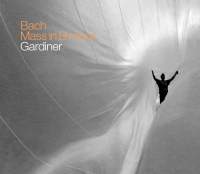Texte paru dans: / Appeared in: |
|
|
Outil de traduction ~ (Très approximatif) |
|
|
Reviewer: Marc
Medwin John Eliot Gardiner’s 1985 B-Minor mass proved to be one of the work’s benchmark recordings, and mine may have been some of the only ears that found it lacking. It is beautifully sung, wonderfully played, and a meticulous, majestic conception with which I never connected on an emotional level. Having now heard much of Gardiner’s recent work, it seems fair to suggest that his Bach pilgrimage in the year 2000 altered something fundamental to his vision as a conductor and musician. The transformation involved drama, or the dramatic union of opposites, but however the shift is articulated, a new depth pervades every new recording. As with his cantata cycle, his motets and St. John Passion remake, this B-Minor Mass exhibits all of the earlier version’s positive attributes while existing on a deeper level, on a higher expressive plane. From the urgency of the first Kyrie, a dual aesthetic is established. There is no doubting Gardiner’s early music credentials, but though it does share similarities, his is not the light and lean approach of John Butt or Jos van Veldhoven, both of whom demonstrate allegiance to Rifkin’s pioneering one-voice-per-part choral approach. Gardiner uses an eight-member chorus, which makes a huge difference in power and perspective. This Mass is transparent when needed but powerful when appropriate, as with that opening declamatory and rawly expressive B-Minor Kyrie, but the D-Major “Christe” brings a huge textural and emotional change. The resultant polarity conjures shades of differing performing traditions; the more transparent moments are closer to Philippe Herreweghe’s most recent version, while the more powerful sections exhibit the raw vitality of Brüggen’s Glossa rendition, though Gardiner’s approach to instrumental deployment and rhetorical flow is like neither. I mean nothing pejorative when I label him a Romantic proponent of period practice. Take, for example, the Agnus Dei aria. Meg Bragle sings it as if she is Hanna Schwarz performing the Nietzsche lines from Mahler’s Third Symphony under Giuseppe Sinopoli, one of my very favorite versions of that complex and constantly morphing movement. Like Schwarz, Bragle veers naturally between the sparsely vibrated clarity associated with HIPsters and a gorgeously rich tone, vibrato full-on, as if she were channeling Janet Baker. Bragle is an inspired choice; her easy fluency in, and unification of, both stylistic spheres perfectly complements Gardiner’s aesthetic, and her traversal of the dynamic spectrum, including the most exquisite pianissimo, is matched by Gardiner’s shaping of the strings’ countermelody. The soloists are drawn from the Monteverdi chorus, which is, as usual, superb, and nowhere more so than in the dual statement of Et expecto that elucidates yet another polarity. Gardiner’s excellent notes observe the power of this section, and his is like no other I’ve heard. Suspensions and chromatic inflections ache with brutal immediacy reminiscent of his stunning take on BWV146’s “Wir müssen durch viel Trübsal.” As with that anguished movement, Gardiner’s riskily extreme tempo and dynamic shifts pay huge dividends as darkness and uncertainty explode into light and victory. It is as if the transformation from angst and gloom to glory has brought Heaven and earth into some sort of alignment, and again, I can’t help hearing the emergences of D-Major in Mahler’s First Symphony paralleled in Gardiner’s conception. As with only the finest performances, the microcosmic gestures encapsulate macrocosmic occurrences. The whole is a series of concentric unities, a spiritual journey along which all manifestations of fear, tenderness, awe and jubilation are explored. | |
|
|
|
|
Cliquez l'un ou l'autre
bouton pour découvrir bien d'autres critiques de CD |
|




